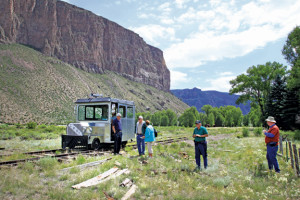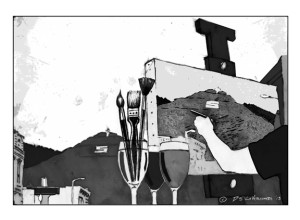By George Sibley
You may not have noticed, but May 18 was “Endangered Species Day.” So it seemed a good time to reflect on an “endangered species” situation under evaluation in Central Colorado, mostly over here in the Upper Gunnison River valleys but also across the divide near Poncha Pass.
The species allegedly endangered is the Gunnison Sage Grouse, which has the distinction of, first, not having been officially recognized as a unique species until 2000, and then, that same year, being immediately put on the federal candidate list for “endangered or threatened” status. Eighteen years of hard work by a Gunnison Grouse Working Group – ranchers as well as environmentalists – here in the Upper Gunnison may have stabilized the local population, but its low numbers in other areas (plus some outside political pressure) have led the Procrustean U.S. Fish and Wildlife Service (FWS) to declare that it will probably be officially listed as “endangered” in all areas this fall. For those who don’t know, this a fate much to be dreaded; it requires a federal “consultation” for almost any action involving land use in “critical habitat” – most of the ranchland in the Upper Gunnison.
The life ways of the Gunnison Grouse – a plump bird that seems to shout “Food Species!” – are precarious to start with. For one thing, they nest on the ground under sage bushes, leaving them vulnerable to egg-and-chick-eating ground predators like coyotes, as well as the avian predators – crows, hawks and eagles. Not to mention accidental damage from large mammals (deer and elk and, now, cattle, horses and humans) that inhabit their nesting areas.
The birds are best known, however, for congregating during the wild kingdom’s breakfast hours on open leks – more descriptively called “strutting grounds” – where the males of the species compete for the attention of the females by doing imitations of the U.S. Senate at work. They fluff up their chest and head feathers, raising a spiky tailfeather array, and inflating then quickly deflating air sacs on their chests with a sound like a Senator Inhofe climate-change harrumph. The long-term effect of this spectacle is to limit their own gene pool to about a third of the males; the shorter-term effect has been witnessed by human voyeurs at these open-place gatherings, watching an eagle or coyote swoop in to carry off a male in full strut. Irony alert: fifty years ago, the eagle was an endangered species, one of the glamorous fauna whose apparently imminent extinction led to the Endangered Species Act. Now the eagle is back, saved – and helping endanger another species.
But the decline of the grouse cannot be pushed off on their “natural” predators; human activities in the West’s sagebrush ecosystem over the past 150 years have been much larger factors – cattle and sheep, horses and humans tromping or driving through their territory; roads and houses and power lines unintentionally displacing them from their strutting and nesting grounds. A 2012 study of the grouses’ plight concluded that they need “landscapes with extremely minimal levels of human land use.” The best thing for the bird, then, would be for humans to just leave – an unlikely resolution that is nonetheless dear to the heart of the “WildEarth Guardians,” one of the national organizations that sued the FWS, forcing them to make decisions about the couple hundred species on the “endangered candidates” list.
But this week I find my mind spiraling out into a bigger picture, nudged there by a book I’ve been reading: The Last Lost World: Ice Ages, Human Origins, and the Invention of the Pleistocene, by a husband and wife team, paleoanthropologist Lydia V. Pyne and Stephen J. Pyne, an environmental historian who has written engagingly for non-scientists on topics ranging from wildfire in America to the origins of the Grand Canyon.
The Pynes’ topic is basically the recent two million years or so on our planet, the geological moment we call the Pleistocene, when the interactions between air and water (global climate) have taken some of the impetus in planetary change, resulting in an epoch of advancing and retreating ice sheets and glaciers.
But all I want to cherrypick from that book today is the Pynes’ observation about the interactions among the several emergent near-human species that evolved in that chaotic time, and a large extinction of species that coincided with our emergence as the human species. They note that, of 514 fellow mammal species around when the big ice most recently retreated 10 to 20 thousand years ago, 207 disappeared prehistorically as humans effectively took over the planet – and the bigger the species, the faster it fell: wooly mammoths, giant buffalo, dire wolves, sabertooth tigers, cave bears and others went first. This is not new knowledge; the general hypothesis has been that we new big-brained, tool-wielding homo sapien sapien killed them off, either defensively, or deliberately for food, or accidentally through occupying and eventually overrunning or altering their habitats. But the Pynes point out that our aggressive approach to environmental competitors is only one of three human responses to other competitor species in the increasingly humanized environment. A second response has been domestication – the big wolves and tigers were eliminated (or nearly so) as incontrovertible competitors, but smaller wolves, Asian elephants, horses and a number of herd animals survived through cooperative work arrangements with us humans.
And the third response they note is very recent: “the practice of deliberately protecting species” – mostly from ourselves – through creating nature preserves and national parks, and legislation like the Endangered Species Act.
This might well be taken as evidence of a kind of evolution – a cultural evolution more conscious and moral than Darwin’s random natural selection. We know that most mammal species have “feelings” and are passionate about their own young and each other, many mating for life and altruistically defending each other against attackers. But we may be the only species that has begun to extend that kind of feeling to other species, to “creation” itself – as the girl down the street learned last week when the beloved family dog killed her beloved pet rabbit.
We may in fact be evolving as something new under nature’s sun, albeit something still working itself out down on the ground. I am reminded of what Julian Huxley said – that, with us, “the universe is becoming conscious of itself.” But more than just being conscious of what we do with and to the world around us, we have begun to be conscientious about it, trying to mitigate old mistakes.
Some of us anyway. Lest I begin to sound sloppily sentimental here, I’ll have to note that we don’t appear to be a uniformly evolved species in that regard. As I write, poachers are slaughtering Africa’s few remaining rhinoceroses and elephants in wildlife preserves for their horns and tusks. It may be that a cultural concern for the damage we have done consciously or unconsciously, and efforts to undo some of that damage, is just the noblesse oblige of the wealthier elements of the culture.
This post-glacial evolution toward consciousness and conscience also obviously wanes as well as waxes. I seriously doubt that in America today an Endangered Species Act could be passed; I doubt we could even get a sensible Clean Air or Clean Water Act through our current Congress. The “haves” and “have mores” who run our society today certainly challenge the idea that great wealth brings forth greater and more generous spirits.
Still, I can’t help but think that the progression pointed out by the Pynes – a two-million-year progression toward not just awareness but caring – is something at least really interesting, if fragile, going on in the universe, and something we need to consciously try to nurture more generally.
There is, however, one thing about it that bothers me, and that is the extent to which this new altruistic impulse seems stuck in a sort of Old Testament undertone of sadness and overly righteous Jehovian anger. The Endangered Species Act is culturally trudging somewhere east of Eden, looking back on The Garden that we imagined the world was before we came along. God’s perfect creation – or if you prefer, Nature’s perfect creation – that we have disrupted through some Original Sin.
Our real “sin,” of course, is just the common “tragedy of success” the planet has seen again and again in many other species: the sin of succeeding too well in planetary competitions to survive. Having “won” in every ecosystemic encounter – even against many of the microbes now – we have become a swarming species, our appetites as well as our numbers endangering practically every species on the planet including ourselves. If our sin is “original” in any way, it is because (now eating voraciously from that Edenic Tree of the Knowledge of Good and Evil) we consciously know a lot about how to control our swarming, maybe reverse it. But, we refuse to broadly implement what we know, mostly for antiquated economic and religious reasons. Instead, we invest our energies in relieving the symptoms of our “sin” through beating each other up with the redemptive “consultations” inscribed in the Endangered Species Act.
So – Happy Endangered Species Day. As one of the endangered to another.
George Sibley writes from Gunnison, where he has never intentionally endangered or even threatened a grouse.



